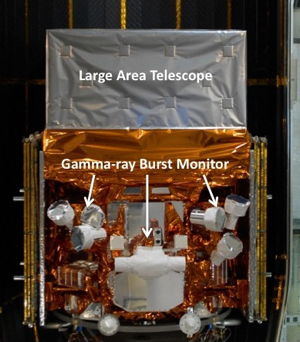About Fermi
The Fermi Gamma-ray Space Telescope is a satellite observatory for photon energies from 8 keV to over 300 GeV. Launched on 11 June, 2008, it circles Earth every 96 minutes in a 26° inclination orbit at an altitude of 535 km.
Fermi carries two scientific instruments, pictured at left: the Large Area Telescope (LAT) and the Gamma-ray Burst Monitor (GBM). Some important performance characteristics are shown below.
The observatory typically operates in a survey mode, allowing a scan of the entire gamma-ray sky every two orbits.
More about the instruments can be found at NASA's Fermi Web site, http://www.nasa.gov/mission_pages/GLAST/spacecraft/index.html
More about Fermi observation modes can be found at the Fermi Science Support Center site, http://fermi.gsfc.nasa.gov/ssc/observations/types/
| Large Area Telescope | Gamma-ray Burst Monitor |
|---|---|
| Pair-production instrument | NaI and BGO scintillators |
| Energy range: 20 MeV to > 300 GeV | Energy range: 8 keV to 40 MeV |
| Field of view: 2.4 steradians | Field of view: 9.5 steradians |
| Single photon angular resolution: <1° at 1 GeV | Gamma-ray burst localization: typical 3° |
| Timing accuracy: 1 microsecond | Timing accuracy: 2 microseconds |
| LAT Web site: https://www-glast.stanford.edu/instrument.html |
GBM Web site: http://f64.nsstc.nasa.gov/gbm/instrument/ |
NASA's Fermi Gamma-ray Space Telescope is an astrophysics and particle physics partnership, developed in collaboration with the U.S. Department of Energy and with important contributions from academic institutions and partners in France, Germany, Italy, Japan, Sweden and the United States.
Some Fermi Science Highlights
- Discovery of the Fermi Bubbles
- Gigantic gamma-ray-emitting structures in our Milky Way galaxy were likely produced by a large energy release from the central black hole several million years ago. - Revelation that the Crab Nebula is not a steady source of gamma-rays
- Dramatic flares with sub-hourly variability indicate sites within the inner nebula accelerate electrons to the highest energies associated with any single known cosmic object. - Elimination of some popular models of dark matter
- Fermi is the only indirect dark matter experiment to set constraints on Weakly Interacting Massive Particle (WIMP) annihilation down to the limit expected from thermal relics. - Proof that cosmic-ray protons can be produced in supernova remnants
- Distinctive gamma-ray signature of neutral pion decay confirms the hypothesis that protons can be accelerated to cosmic-ray energies in remnants. - New view of the universe!
- Factor of 10 increase in known gamma-ray sources from 100 MeV to 300 GeV accompanied by factor of 5 increase in gamma-ray source classes.
- Enabled discovery of ~1/3 of all known Galactic field millisecond pulsars, unique probes of neutron star physics and significant additions to those used for gravitational wave searches with pulsar timing arrays.
- Discovery of gamma-ray novae
- Direct support for Einstein's proposed Lorentz invariance (constant speed of light for all energies)



